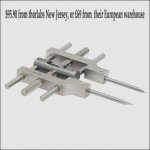Thanks John,
Useful tips. I have been using thin rubber gloves, but they really make my hands wet. The vacuum cleaner is always handy when I am working on binoculars, has saved me from having to remove a prism by sucking the offending particle out on more than one occasion.
I came across this optical spanner wrench yesterday, the company is nothing to do with me I stress, but it is the best one I have seen, you just pull out and turn the end prongs round if you want the flat ends instead of the points. It looks a high quality piece of kit, but is very expensive though, my own wrench was only £16, this is nearly £70.
Useful tips. I have been using thin rubber gloves, but they really make my hands wet. The vacuum cleaner is always handy when I am working on binoculars, has saved me from having to remove a prism by sucking the offending particle out on more than one occasion.
I came across this optical spanner wrench yesterday, the company is nothing to do with me I stress, but it is the best one I have seen, you just pull out and turn the end prongs round if you want the flat ends instead of the points. It looks a high quality piece of kit, but is very expensive though, my own wrench was only £16, this is nearly £70.
Attachments
Last edited:





